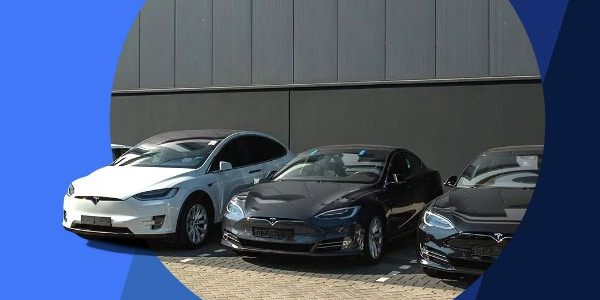For businesses that rely on a fleet of vehicles – from delivery vans to construction trucks – keeping those vehicles running smoothly and efficiently is paramount. But these workhorses don’t last forever. At some point, every vehicle reaches a tipping point where breakdowns become more frequent, repairs become more expensive, and overall performance suffers. This is where a well-defined fleet replacement strategy becomes absolutely crucial.
A strategic approach to vehicle replacement goes beyond simply swapping out an old car for a new one. It’s about optimizing your fleet’s lifecycle for maximum productivity and cost-effectiveness. Neglecting a proper strategy can have significant consequences. Imagine facing a surge in maintenance costs as your vehicles age, or worse, dealing with safety risks posed by unreliable equipment. Unscheduled downtime due to breakdowns can also cripple your operations and put a damper on customer satisfaction.
In today’s post, we’ll delve into the key elements of a successful fleet replacement strategy, helping you navigate the decision-making process and ensure your fleet remains a reliable asset for your business. We’ll explore factors like lifecycle costs, technological advancements, and safety considerations, all with the goal of keeping your fleet operating at peak performance.
Why a One-Size-Fits-All Approach Doesn’t Work
The temptation to implement a one-size-fits-all replacement schedule across your entire fleet might seem appealing – after all, simplicity has its merits. However, the reality is that the ideal replacement cycle for each vehicle can vary significantly.
No magic number applies universally. Instead, the optimal replacement timing hinges on a combination of factors specific to your fleet and its operation. Let’s explore some of the key considerations that influence replacement decisions:
Vehicle type: A heavy-duty truck used for daily construction work will naturally have a shorter lifespan compared to a fuel-efficient sedan used for occasional sales calls.
Usage patterns: Vehicles that rack up high mileage on highways will experience different wear and tear compared to those used primarily for short, stop-and-go commutes.
Budget constraints: Financial limitations may necessitate extending the lifespan of certain vehicles, while others operating in critical roles might warrant a more frequent upgrade cycle.
Key Factors to Consider When Developing a Fleet Vehicle Replacement Strategy
Developing a successful fleet replacement strategy requires careful consideration of several key factors. Here are some of the most important aspects to keep in mind:
Vehicle age and mileage
As a vehicle ages and accumulates miles, it becomes increasingly susceptible to breakdowns and performance issues. Maintenance costs typically rise significantly as parts wear out and require replacement. Reliability also diminishes, leading to unplanned downtime and potential safety risks.
Industry benchmarks suggest typical replacement cycles vary depending on the type of vehicle. For instance, light-duty sedans used for regular commutes might be replaced every 4-5 years or 100,000 miles, while heavy-duty trucks operating in demanding conditions might necessitate replacement every 7-8 years or 150,000 miles. However, these are just starting points – your specific strategy should be tailored to your fleet’s experience.
Vehicle usage
The way you use your vehicles has a major impact on their lifespan. Vehicles used for daily commutes will experience different wear and tear compared to those used for long-distance hauling. For instance, delivery vans with frequent stop-and-go driving put extra stress on brakes and transmissions, while highway miles might lead to faster tire wear.
Analyzing your usage patterns allows for a more nuanced approach to replacement. Vehicles subjected to higher stress might require a shorter replacement cycle to prioritize reliability and safety, while those used less intensively might be viable candidates for extending their lifespan.
Fleet maintenance costs
As vehicles age, a sharp rise in maintenance costs can be a telltale sign that replacement is imminent. Constantly addressing repairs can quickly become a financial burden, draining resources that could be used for preventive maintenance on newer vehicles.
The concept of Total Cost of Ownership (TCO) comes into play here. TCO goes beyond the initial purchase price and considers the total cost of owning and operating a vehicle throughout its lifespan, including fuel, maintenance, repair costs, and depreciation. By factoring in rising maintenance costs, TCO analysis can provide valuable insights into when replacing a vehicle becomes the most effective option to realize cost savings.
Technology advancements
The automotive industry is constantly evolving, with new vehicle models offering improved fuel efficiency, advanced safety features, and potentially lower long-term operating costs. While the upfront cost of a newer vehicle might be higher, the fuel savings and reduced maintenance needs can translate to significant cost benefits over time.
Strategies to Optimize Your Fleet Replacement Plan
With the key factors in mind, let’s explore some strategies to create a truly optimized fleet replacement plan:
Data-driven decision making
Don’t rely on gut instinct when it comes to replacing vehicles. Leverage the power of data-driven metrics! Utilize your fleet management software to gather valuable insights from real-world usage. Analyze maintenance records to identify vehicles experiencing frequent repairs. Track fuel consumption to see if older models are lagging behind in efficiency. By using this data to identify problem vehicles, you can make informed decisions about replacements, prioritizing those that are costing you the most.
Lifecycle cost analysis
Move beyond simply looking at the initial purchase price when making replacement decisions. Instead, consider performing a lifecycle cost analysis (LCA) for each vehicle. LCA takes a holistic view, factoring in all ownership costs over a vehicle’s lifespan, including:
- Initial purchase price
- Fuel costs
- Maintenance and repair expenses
- Registration and insurance fees
- Depreciation
By performing an LCA, you can identify the point at which keeping an older vehicle becomes less cost-effective than replacing it with a newer, more efficient model.
Standardization and diversification
There’s a balancing act to be struck when it comes to your fleet composition. Standardizing your fleet with a limited number of vehicle models can offer several advantages. For instance, streamlining your parts inventory simplifies maintenance and reduces costs. Mechanics become more familiar with specific models, potentially leading to faster and more efficient repairs.
However, complete standardization might not always be ideal. Diversifying your fleet with different vehicle types allows you to cater to specific needs. For instance, you might have fuel-efficient sedans for sales reps and heavy-duty trucks for deliveries. The key is to find the right balance between standardization for efficiency and diversification for functionality.
Remarketing strategies
Once you’ve identified vehicles for replacement along with their resale value, explore remarketing options to recoup some of your investment. Selling or trading in older vehicles can generate funds that can be used towards purchasing new ones. Work with a reputable dealer or utilize online auction platforms to maximize the return on your used vehicles.
In Conclusion: Building a Fleet Replacement Strategy for Success
Developing a successful fleet replacement strategy is about maximizing efficiency and minimizing costs. A one-size-fits-all approach won’t cut it. Instead, consider a variety of factors, including vehicle age, usage patterns, maintenance trends, and technological advancements.
Remember, data is your friend! Utilize fleet management data and vehicle lifecycle cost analysis to make informed decisions about when to replace vehicles. Explore options for standardization and diversification to optimize your fleet’s composition. Finally, don’t forget to consider remarketing strategies to recoup some of your investment in older vehicles.
By taking these steps and carefully tailoring your strategy to your specific needs, you can ensure your fleet remains a reliable and cost-effective asset for your business. Remember, a well-maintained and efficient fleet translates to smoother operations, happier customers, and a significant edge over the competition. So conduct a thorough analysis, craft a data-driven plan, and watch your fleet become a powerful driver of your business success.
How Spring Free EV Can Help
Spring Free EV specializes in providing innovative financial solutions for electric vehicle fleets and can significantly help fleet managers mitigate risks. Our services are designed to address the key challenges fleet managers face when adopting electric vehicles.
First, our low down payments offer financial flexibility and lower upfront costs. We also understand the concerns around battery life and replacement costs, and will work with you to mitigate the risks associated with battery degradation.
In addition, Spring Free EV advises and supports fleet managers as they install charging stations on the company’s premises and along key routes. This is part of our commitment to provide fleet managers with access to resources, tools, and fleet management software that help optimize operational efficiency.
Above all, we make it easy to scale with popular electric vehicles, with leasing structures built for high mileage taxi, car rental, and corporate/company vehicle use.
Contact us today to see how we can help you manage risk as you acquire an EV fleet.

